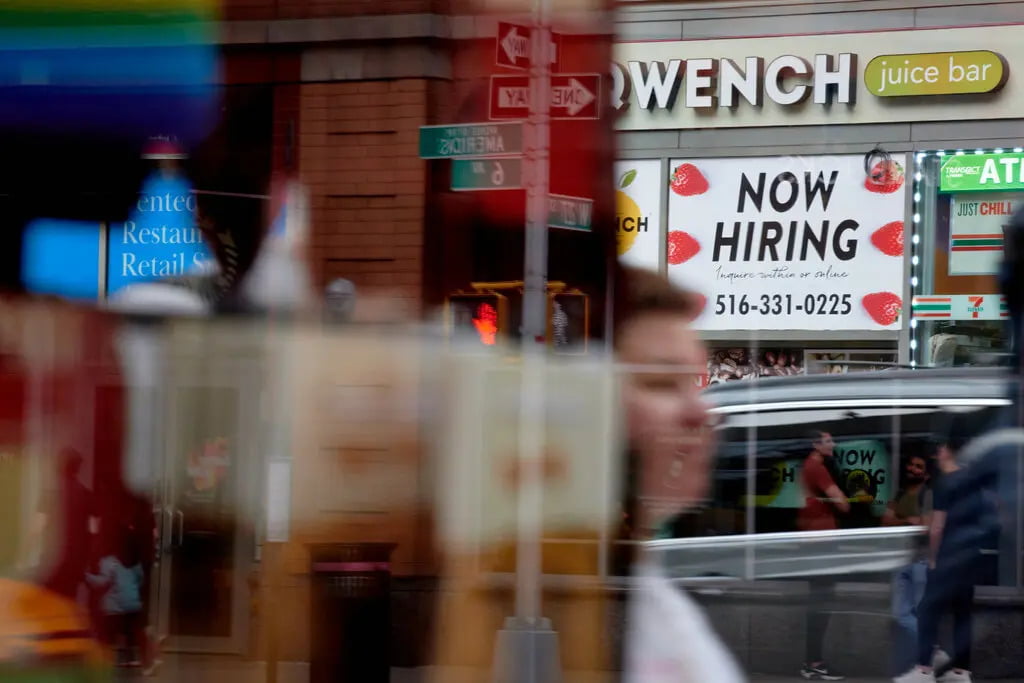As recruiting for white-collar jobs slows down, the U.S. labor market is moving toward specialized workers.

In Short
- Us labor market dividing into sectors: skilled labor and declining demand for “knowledge-based” specialists.
- Latest data shows greater unemployment in professional services than manufacturing.
- Experts note high demand for both “brain and brawn” in the job market.
TFD – Discover how the US labor market is shifting towards specialized workers and the impact on employment dynamics.
According to analysts, the US labor market is becoming more and more divided into two sectors, with a consistent need for skilled laborers and a declining desire to hire more “knowledge-based” specialists.
The data provides proof of this, indicating that workers in professional and business services had a greater unemployment rate than those in manufacturing.
Brain and brawn are in high demand, and there is a buyer’s market for both,” stated Aaron Terrazas, the chief economist at Glassdoor, a job and workplace search website.
On Friday, the Bureau of Labor Statistics reported the latest monthly payroll data for the U.S. economy. Total employment rose by 175,000 in April. The unemployment rate rose slightly to 3.9% from 3.8% in March.
That came in below estimates of 240,000 jobs for April.
There were some encouraging responses to the jobs report’s softening. Stock futures jumped after the news. The overheating of the US economy has been the main source of concern, along with the possibility that inflation could climb further and compel the Federal Reserve to maintain higher interest rates in an attempt to cool the economy and rein in price increases.
Top economic counselor to President Barack Obama, Jason Furman, remarked on CNBC’s “Squawk Box” that the report was a “goldilocks” one, pointing to a potential gentle landing of low unemployment and moderate inflation.
“In summary, this report provides a great deal of comfort,” stated Furman, who is currently a Harvard lecturer.
It’s not that low-wage occupations are the only or even the majority of jobs produced in America. With a 4.5% increase in payrolls over the previous year, or almost 750,000 new jobs, the health care sector continues to lead the job boom. Along with various manufacturing sectors, other areas experiencing rapid expansion include government employment, specific fields within social service, travel, tourism, and the arts.
However, as evidenced by a survey released earlier this week that showed the hiring rate continuing to veer sideways, the labor market as a whole is still at a standstill. Simultaneously, there is little change in the rate of employees departing or being laid off. Economists at The Burning Glass Institute research group, directed by Guy Berger, refer to it as the “great stay.”
He stated in his Substack email on Wednesday that “it’s a good time to have a job, but a not-so-good time to be actively looking for one.”
Many American consumers have also begun reporting signs of a deteriorating job situation. In its latest report on consumer confidence, the Conference Board business group said respondents to its monthly survey reported feeling less positive about the current labor market and more concerned about future business conditions, job availability and income.
This was consistent with results from the New York Federal Reserve’s monthly consumer expectations poll, which showed that a greater number of respondents were negative about losing their jobs or finding new ones. The average probability that a respondent would lose their job in the next year was approximately 1 in 6, which is higher than pre-pandemic levels and the highest reading since September 2020.
“On the margin, businesses are not as eager to add staff,” Wells Fargo managing director and senior economist Sarah House stated.
However, why have payroll statistics stayed stable? One explanation is a greater supply brought about by both a surge in immigration and higher labor force participation rates.
“There is increased labor ‘supply’ for businesses that do want to hire or add staff,” House stated.
However, she stated that if they haven’t already, such patterns will probably also decline.
The fact that so few people are still receiving unemployment benefits is one indication that the job market is still robust.
According to Joe Brusuelas, principal and chief economist at RSM US LLP, “we’re seeing a gradual and orderly slowing” in employee resignations and job openings at businesses. That aligns with businesses in the private sector “carefully managing their labor force.”
The head of the Federal Reserve, Jerome Powell, stated on Wednesday that the bank does not plan to alter its benchmark interest rate anytime soon, despite the fact that its efforts to slow down price increases have stagnated and the labor market appears to be deteriorating.
Rejecting any suggestion that there would be “stagflation” in the economy, he stated that the central bank has “the luxury of strong growth and a strong labor market” that will allow it to maintain interest rates until inflation declines much more.
But in case the job market “unexpectedly” deteriorates, he raised the possibility of a rate cut.
Powell stated, “We’re now focusing on the other goal,” alluding to the Fed’s dual mandate of balancing price increase with employment as long as inflation stays low.
“Now, the job objective is once again in focus. So, that is our main concern,” he stated.
David Wessel, director of the Hutchins Center on Fiscal and Monetary Policy at the Brookings Institution, wrote on X, “These are the #jobs numbers that Jay Powell was hoping for.”
Conclusion
The US labor market is witnessing a shift towards specialized workers, highlighting the demand for a diverse range of skills. Understanding these trends is crucial for navigating the evolving job landscape.
Connect with us for the Latest, Current, and Breaking News news updates and videos from thefoxdaily.com. The most recent news in the United States, around the world , in business, opinion, technology, politics, and sports, follow Thefoxdaily on X, Facebook, and Instagram .
